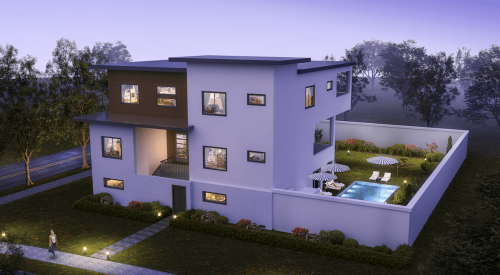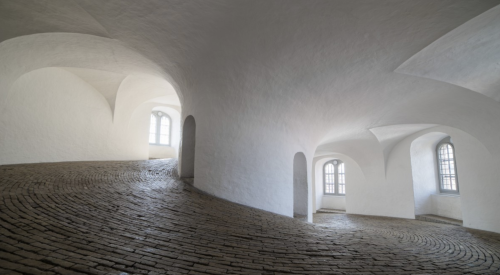Light commercial builders across America have long used concrete, tilt-up wall systems for fast erection of structures such as banks, restaurants, and retail stores. Now some Florida residential builders are finding advantages in tilt-wall technology over conventional, site-built concrete block walls.
| In Florida builder Wally Sanger’s tilt-wall system, factory-produced wall panels are trucked to the building site, where walls for a home can be erected in two to three hours. |
West Palm Beach home builder Wally Sanger, 57, who pioneered his own factory-built, tilt-wall system earlier this decade, even predicts tilt-wall will soon take business away from wood frame for single-family, condo, and apartment construction throughout the Sunbelt. He’s now franchising his patented wall system around Florida and into surrounding states.
"If you look at the rest of the world, everybody but us is building houses out of concrete, in one form or another," says Sanger. "With lumber subject to so much price volatility, I think the industry here will eventually move in this direction."
Sanger’s system—marketed under the name "Royall Wall"—produces wall panels that are, in many ways, similar to those used by some production builders for wood frame construction. "If you look at our wall, every two feet you’ll see a stud. Instead of wood, it’s a column of concrete—with a piece of steel imbedded in it. It’s in there to make it simple to drywall over. The top plate is structural—a 20-gauge piece of steel to which we can fasten metal straps, to hold a truss down. That connection has been tested to withstand 10,000 pounds of pull-out force."
Why Panelize Concrete?
"When I moved down here from Ohio in 1981, I started building frame homes," says Sanger, "because that’s what I knew how to build. I even had my own carpentry crews. After Hurricane Andrew, it became hard to sell frame houses in South Florida. The alternative was concrete block. The more I learned about that, the less I liked it. So I came up with this system to get both the energy efficiency of wood frame and the strength of concrete."
| The 2582-square foot Odessa model at The Estates in Royal Palm Beach, Fla., where Sanger’s company—Royall Professional Builders—sells it for $208,000.
|
He admits his system is really just a concrete adaptation of panelization principles perfected in wood by Ryan Homes in the 1960s. "This is the same thing, except we’re producing a concrete panel reinforced with wire mesh. It’s much heavier, so it’s harder to ship long distances and stay competitive. That’s why we’re going to a franchise system."
Sanger perfected his system in his own company, building 100 to 120 single-family houses a year in the Royal Palm Beach market. He’s still doing it, with an average sale price of $160,000. But by the mid-1990s, he started getting calls from other builders asking to use his system. Over the decade, consumers (and builders) began to see value in the strength and energy efficiency of Sanger’s wall system. But they also demanded increasingly complex floor plans as houses became larger.
"We had to become a lot more sophisticated in our engineering, and with our labor crews in the plant, to build those complex walls," says Sanger. "Now we can do anything from entry-level affordable houses with an eight-foot plate to 10,0000 square-foot luxury homes with 22-foot plate height."
| This four-bedroom, 2011-square foot home in Royal Palm Beach, Fla., sold for $145,000. Walls are designed to withstand hurricane force winds to 265 mph and airborne debris impacts to 85 mph.
|
Royall Wall is also now successfully competing with block on jobs such as elementary schools and high-end multifamily condo buildings.
Like Living In A Food Locker
The majority of wall panels Royall Wall produces are 5-1/2 inches thick, with two inches of 6000-psi concrete on the outside and 3-1/2 inches of polystyrene bead board on the inside. The concrete exterior is designed to withstand 260-mph winds and has been tested to withstand 85-mph impacts from airborne debris, a positive in hurricane-prone South Florida. The polystyrene acts as insulation and also makes the panels lighter and easier to transport.
"It’s almost like living in a food locker," says Sanger. "We’ve had buyers tell us their air conditioning costs are half what they spent in a concrete block construction house of the same size. And I’ve built over a thousand homes using this system without ever having a call about a termite problem."
Sanger says his franchisees will be able to move quickly from getting a set of plans from a builder to delivering wall panels to the building site. "Right now, when we get a set of plans, our engineers present an estimate in a day. Once we go to contract, it takes five working days for engineering to do a set of plans, then three days to build the forms for each house, to where we’re ready to pour concrete."
"We can easily go from initial contact to having trucks on the road within a couple of weeks," says Sanger. "When we hit the site, that’s where we really shine. We can have the walls up within two to three hours, and many builders get roof trusses on in the same day. Elimination of trades and speed of construction are what impresses builders. But consumers are impressed with the strength of the wall and insulation values."
The panels are trucked to the site, where they are unloaded and set in place by crane. Panels are connected using a bolt through pre-punched steel plates. The crew places the panels, braces them with screw jacks, and grouts horizontal edges to seal against air and water penetration. Panels have shiplap joints on side edges to fit snugly against each other. The exterior concrete has a slightly roughened finish that provides good stucco adhesion without bonding agents. Other finishes, such as siding or brick facing, can also be used.
The steel studs that reinforce panels, running vertically every two feet, lie flush with the inside surface-to allow drywall application. Each window and door opening is surrounded by a reinforced concrete beam. The builder is responsible for specifying electrical and plumbing penetrations, but Royall Wall creates all those raceways in the panels during fabrication in the Royall Wall’s plant.
Less Labor On-Site
"Our early growth has been fueled by the labor crisis in Florida construction trades," says Sanger. "We’re cutting site labor way down, in both numbers of workers and time required. As a builder, what I really love is that it speeds up my processes by at least two weeks. Once that slab is set, I can go out the next day and set walls. And there’s no inspection required on the walls. Our engineers certify that they’re right. You can set the trusses the same day, with the same crane. Inspections are really slowing a lot of builders down. Getting inspectors out can take days, and the job stops until they show up."
"Henry Ford proved a long time ago that factory production is more efficient. That’s the difference between our system and most other forms of tilt-wall construction. We build our panels in a plant, where we can control production and exercise economies of scale by buying everything in bulk."
Sanger admits Royall Wall is more expensive than conventional concrete block construction. "If you just compare materials cost, we’re probably 30 to 40 cents a square foot more," he says. "But that’s not a fair comparison. That doesn’t give us credit for the time savings we achieve, or the reduction in waste at the end of the job. And our builders are not storing large quantities of materials on site, where they are subject to theft."
Even so, Florida’s large production builders are wary. One who asked not to be quoted by name said he’s looked at Royall Wall and can’t make the numbers work in a highly price-competitive market. But he also admitted to reservations about ever going to a technology where another company holds the patent. "That makes me nervous," he says.
Still, Royall Wall now has franchisees in West Palm Beach, Jacksonville, Orlando, Sarasota, and Ft. Lauderdale, as well as Sanger’s own operation in Royal Palm Beach. The number of builders using the system continues to grow, and some of them are quite large. For instance, Frank Young of Sunland Homes in Royal Palm Beach, builds 250 homes a year and 95% use the Royall Wall system. "Because we build stick, block, or precast homes at the same rate, price isn’t a factor," he says. "We wanted something different, something stronger and more energy efficient. When we changed to this system from stick and block, our sales jumped about 75%."
John Sneep of Majesty Builders in West Palm Beach is also enthusiastic. "Technology has developed so that concrete must be considered by every builder as an aid in providing energy efficient homes," he says. "Builders can no longer depend on traditional methods."
Sneep has two installation crews, who have erected walls on as many as five houses in a single day. "This system is neat, clean, with no mess or fuss," says Sneep, who says homes built with the panels cost about the same as conventional block or wood frame, assuming those walls are furred and insulated with three to four inches of fiberglass.
Sanger believes the key to future success for Royall Wall lies with exploiting its appeal to housing consumers rather than builders.
"Builders are like farmers," he says, "very resistant to change. Even proving that consumers are willing to pay for this, and that they’ll make any extra cost back in energy savings over the first three years is often not enough. They have to be convinced it’s not going to cause them problems. They worry about dealing with different people instead of the same trades they’ve always used."
"We think this system will work throughout the Sunbelt. We’re negotiating with a potential major franchisee in Georgia. We’ve had interest from Texas and the Bahamas. But we know the secret is creating demand among home owners and shopping consumers. We have to market directly to end-users."
"We have not lost a job that we bid on with an owner/builder. The biggest thing is always the strength of the walls and the insulation values. You can’t tell me those things don’t matter to buyers. Quality and value have never been as important as they are today."












